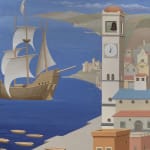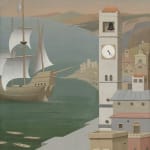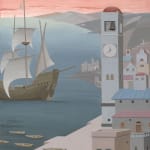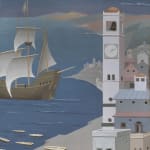
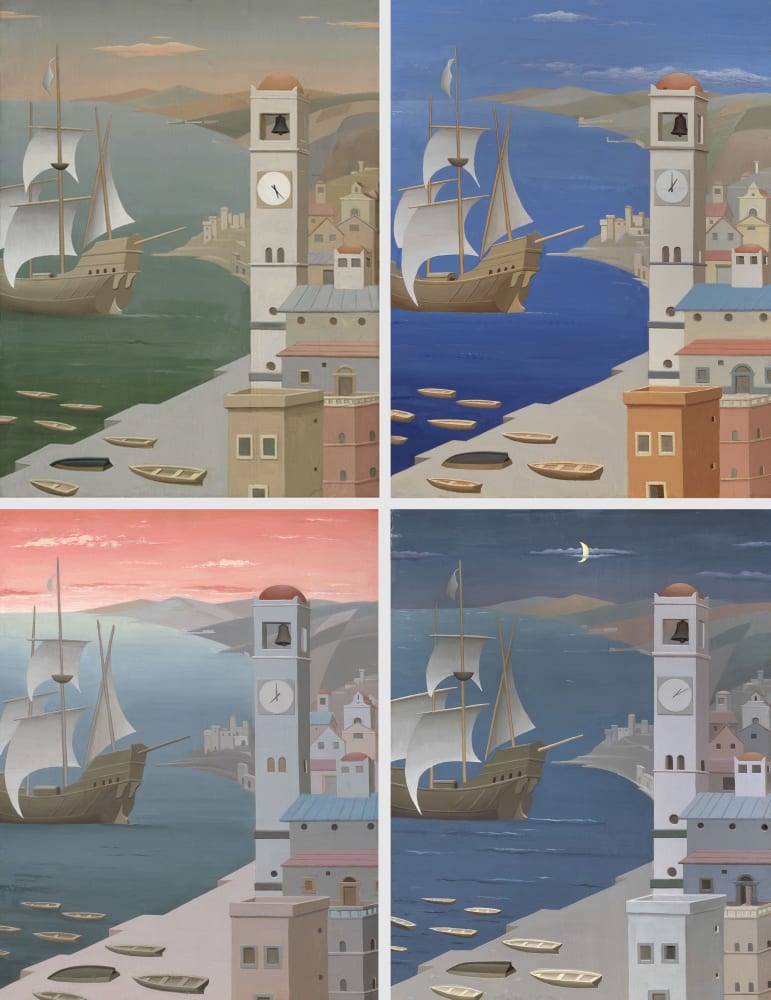

Dawn

Dusk

Night

EDITA BROGLIO SMILTENE (RUSSIA) 1886-ROME 1977
Further images
Exhibitions
Galleria Russo, Rome, 1961;
Galleria del Levante, Edita Broglio, curated by Raggianti, Milan, 1971;
Galleria La Strozzina Firenze, 1971;
Palazzo Ricci, Edita Broglio: evoluzione dello stile, in Edita Walterowna Broglio, curated by Giuseppe Appella, Mario Quesada, Anne-Marie Sauzeau Boetti, Macerata, 1991;
Bonacquisti, Una profondissima quiete. Francalancia e il ritorno alla figura tra De Chirico e Donghi, curated by Beatrice Avanzi, Vittorio Sgarbi, Michele Dantini, Assisi, 18/5-4/11 2018;
Palazzo Cucchiari Carrara, Il Mare: Mito Storia Natura, curated by Massimo Bertozzi, Carrara, 2022.
Literature
Edita Broglio, catalogue of the exhibition with words by Giorgio De Chirico, Rome, Galleria Russo, 23 January – 1 February 1961, Rome 1961;
Cipriano Efisio Oppo, Edita Broglio, in “Il Globo”, Rome 31 January 1961;
Carlo Ludovico Ragghianti, Edita Broglio, catalogue of the exhibition by Raffaele Monti and La Strozzina di Firenze, Galleria del Levante, Milan 1971, n. 33 Meriggio; n.34 Notte; n.35 Alba; n. 36 Occaso; (ripr. Occaso);
Mario Quesada, Edita Broglio: evoluzione dello stile, in Edita Walterowna Broglio, catalogue of the exhibition by Guseppe Appella, Mario Quesada, Anne-Marie Sauzeau Boetti, Macerata Palazzo Ricci 15 June – 29 September 1991, pp. 17 – 20, in part. p. 20;
Anne-Marie Sauzeau Boetti, Edita Walterowna, in ibidem, pp. 21 – 28, in part. p. 21;
Leonardo Mancino, Freschi, chiari valori plastici divorati dal sole, in “La gazzetta del Mezzogiorno”, 12 September 1991 (ripr. Le quattro ore del giorno: Mezzogiorno); Una profondissima quiete. Francalancia e il ritorno alla figura tra De Chirico e Donghi, curated by Beatrice Avanzi, Vittorio Sgarbi, Michele Dantini, Palazzo Bonacquisti, Assisi, 2018, pagg. 78-79;
Literature:
Il Mare: Mito Storia Natura. Arte italiana 1860-1940, catalogue of the exhibition at Palazzo Cucchiari, Carrara, 9 July - 30 October 2022. Pag. 163,164,165,166
When Giuseppe Ungaretti wrote the introduction to Edita Broglio’s one-woman exhibition at the Galleria del Vantaggio in Rome in 1957, he may well have been thinking of the Four Hours of the Day, exemplary works of the style of painting favoured by this artist of Latvian origin – though Italian by adoption (1) – in the years after World War II when, particularly after her husband’s death, her research became increasingly narrow and focused on light and on the changes in colour occasioned by that light.
In those mature years, in addition to the Four Hours of the Day, Edita painted such works as Colour Symphony – declining it the versions vivace, andante, allegro and moderato (1951) – and Overcast Sky and Clear Sky (1954). These pictures share the fact that they show the same subject repeated several times over, where in each “frame” the artist explores in painting the impact of the changing conditions of light and atmosphere on colour.
They are the works of a mature and unique artist which, if set in sequence, produce a song, possessing an almost musical rhythm and evoking the poetry of Raymond Quenau’s Exercices de style (Gallimard, Paris 1947); they are pictures that constitute the crowning achievement of the artist’s ancient dream involving gleaning the secret values of light and of its phenomenic properties, the dream that may well have been the driving force which prompted Edita to come to Italy so many years ealier.
The first known showing of the four paintings was at the Galleria Russo in Rome in January 1961. On that occasion they were reviewed by Cipriano Efisio Oppo, who described them as: “…a harmony modulated in accordance with the changing light, at Dawn, Noon, Dusk and Night”, detecting in the paintings “an aspect that is always extremely poetic as well as painterly…”(2).
It is interesting to note the emphasis laid by both critic and painter on the work’s poetic aspect, a characteristic aspect of Edita’s art which Giuseppe Ungaretti had already highlighted in his introduction of 1957: “… where every relationship is precise, where every object, beloved through its having been explored and considered in every minute detail, shines with an absolute light. The result is a poetry which enchants the meticulous, refreshes the eyes, soothes the senses and urges infinite contemplation, the serenity of poetry...”(3). In that short sentence Ungaretti shows how well he knows: her “exploring and considering” objects in every detail; in other words, her very approach to the practice of art. But he says more than that: it is the practice of art that leads the artist to love what she paints – rather than the other way around, as one might be inclined to think – in fact one might almost be tempted to call it a monastic practice that once embraced, leads in its turn to poetry: in other words, for Edita everything starts with the painting, not with its subject.
This approach to painting shines through very clearly in the study for the Four Hours of the Day: Night published at the posthumous exhibition in Macerata in 1991, shedding light on the artist’s working method.
First and foremost, it is a study from life in a small format. The study itself already contains every element of the final painting (albeit rendered with summary brushstrokes), perfectly identified in the pictorial space. The mountains shading off into the distance, the village bell-tower and building, the ship drawing closer, its sails unfurled as it prepares to dock, the small boats drawn up on the shore or riding at anchor: everything is already there, in every detail, as is the full range of the artist’s palette. Yet she wants more: she wants “absolute” truth, the absolutely “eternal”, which can be achieved only by eliminating every circumstantial element (starting with the human element) and by dominating matter without ever making any concessions to superficial solutions, a goal that is achived through the passionate exploration of painterly technique with daily practice bolstered by a study of the art of the past.
This is not something that can be improvised. The pictures are skilfully painted and intensely meditated: each work in the Four Hours of the Day constitutes the bulwark of those years, in which each component part – form, light, colour – is balanced and perfect in relation both to itself and to its companions.
These paitings are the end product of a lifetime’s study. They represent the sum of the experiments begun almost fifty years earlier with her husband, the painter Mario Broglio, with whom, together with the young artists working in Rome in the 1920s, she founded and worked on the periodical “Valori Plastici”(4) and its associated publishing company.
When Broglio died in the 1950s, Edita embraced and internalised, once and for all, the totality of her past experience stretching from “Magical Realism”(5), the movement within which she had produced some of her most enchanting works in the 1920s and ’30s, immersed in an atmosphere of frozen suspension (the same atmosphere that permeates every one of the Four Hours of the Day), to her study of the painting of the old masters such as Giotto, Piero della Francesca and other 14th century artists, which she rediscovered in the company of the painters gravitating around the periodical. She pursued that study with increasingly radical intensity throughout the 1930s, when she began to show her work less(6) and to pursue her research with consistency, triggering what she was to call the “second phase” of her painting which, as she herself wrote “....is shaped by the need to distinguish between appearance and reality, to realise that temperament, inspiration and skill are hostile elements averse to art, which on the contrary requires discipline, moderation, obedience, where knowing the limits of matter (which is by nature rebellious), making it ductile and singing so that it responds in subjection, yet without sacrificing the volume, the three dimensional nature of things – nagging considerations, which have taught me that form alone is capable of breathing life into content.”(7).
- Giovanna Caterina De Feo
Notes
- Born into an aristocratic Baltic family in Smiltene in eastern Latvia, she left her home at an early age to visit first Paris in 1910, where she frequented artists’ workshops, and then Italy, travelling to Florence in 1911 and then on to Rome where she settled in 1912, setting up a workshop only a stone’s throw from Villa Strohl-Fern, a meeting point for artists of different nationalities, and coming into contact with the international salon of Olga Resnevich Signorelli who introduced her into the city’s artistic circles. She showed her work at the II Esposizione internazionale d’Arte della Secessione in 1914, going on to forge close ties after the war with the “Novissima Film” studios for which Anton Giulio Bragaglia was about to film Thais (1915) with a script by Enrico Prampolini, and to its Casa d’Arte, in which it was to host exhibitions of this new art after 1918; it was here that she met Mario Broglio (Pavia 1891 – Lucca 1948), who was to become her partner in life and in painting.
- Cipriano Efisio Oppo, Edita Broglio, in “Il Globo”, Rome 31 January 19
- Giuseppe Ungaretti, preface to the Edita Broglio catalogue, Galleria del Vantaggio, Rome, 29 October 1957
- In 1922 she was with the “Valori Plastici” group at the springtime Fiorentina; the group was presented by Alberto Savinio and Edita showed her work with Amerigo Bartoli, Carlo Carrà, Giorgio de Chirico, Ugo Giannattasio, Arturo Martini, Giorgio Morandi, Cipriano Efisio Oppo, Carlo Socrate and Armando Spadini. It is worth pointing out that in taking the exhibition “Das Junge Italien” to Berlin the previous year, Broglio had contributed to the birth of the Neue Sachlichkeit in Germany.
- According to the “Magical Realism” developed in literature in Italy by Massimo Bontempelli, magic gushes forth unexpectedly from daily life, from everyday actions and objects reproduced in a hyper-realistic fashion, immersed in an amazed and enchanted atmosphere.
- After 1935 Edita opened a workshop with the husband, the two artists’ painterly research merging into a four-handed approach. She showed her work at the 3rd Quadriennale in 1939 and in the postwar era under the pseudonym “Rocco Canea”. When Mario Broglio died on 22 December 1948, Edita lived out her widowhood at San Michele a Moriano, in the province of Lucca, until 1955, regaining her own expressive research and revisiting her early Russian experience in her years there. She returned to Rome in 1955 and continued to publish Valori Plastici for some years thereafter. She showed her work at the Rome Quadriennale in 1959 and at the exhibition on “Italian Art from 1915 to 1935” curated by Carlo Ludovico Ragghianti in Florence in 1967. She died in Rome on 19 January 1977, on the feast day of St. Mario, and is buried in the non-Catholic cemetary at Testaccio.
- Edita Broglio, Riassumo, essay in Edita Broglio exhibition catalogue, Florence, La Strozzina, 1971
Join the mailing list
Subscribe to our newsletter to receive all the news about exhibitions, fairs and new acquisitions!
